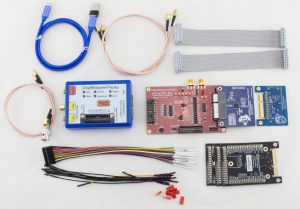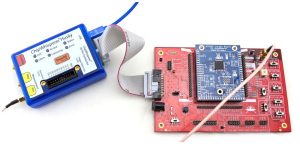 The ChipWhisperer-Hucky is a revolutionary device developed by NewAE Technology Inc. for working on advanced hardware attacks like power analysis and fault injection. Key features include high-speed logic analyzers (to visualize glitches), real-time data streaming for attacking asymmetric algorithms, support for JTAG/SWD programming with an FTDI-compatible mode, and additional I/O expansion pins. The entire FPGA core and supporting software are open-source, which means you can use it for implementing new ideas you are developing.
The ChipWhisperer-Hucky is a revolutionary device developed by NewAE Technology Inc. for working on advanced hardware attacks like power analysis and fault injection. Key features include high-speed logic analyzers (to visualize glitches), real-time data streaming for attacking asymmetric algorithms, support for JTAG/SWD programming with an FTDI-compatible mode, and additional I/O expansion pins. The entire FPGA core and supporting software are open-source, which means you can use it for implementing new ideas you are developing.
Since the launch of ChipWhisperer-Husky on Crowd Supply in 2022, there have been various exciting new features added to the hardware, and new demos released.
The biggest new development to hit Husky is sequenced triggers. This allows you to specify a sequence of events that need to occur for Husky to trigger. For example, you can use this to specify that Husky will trigger when it sees a GPIO change followed by a specific UART string (within a specific time window), or when it sees an ARM debug trace event followed by a specific analog waveform pattern. This last example is used in the new ECC notebook, where you can see how triggering from a trace/SAD sequence makes it much easier to attack ECC.
Multiple new ChipWhisperer-Husky demos have been released over the past year. A notable example uses open-source JTAG implementation to talk to target devices from the I/O pins on the ChipWhisperer Husky, which is documented in a new UserIO JTAG Notebook. This means you can also trigger the ChipWhisperer-Husky from JTAG commands.
 As an open-source tool, an important part of that is how easily you can make changes to it. From the start, the ChipWhisperer-Husky had a comprehensive verification environment, which is critical when working with FPGA designs. Recently Husky’s verification environment has gotten a big upgrade. The previous Verilog/Python hybrid testbench has been replaced by a pure Python testbench, using cocotb. This allows NewAE Technology Inc to cover more of Husky’s functionality in simulation, which will result in faster development and less risk of introducing bugs.
As an open-source tool, an important part of that is how easily you can make changes to it. From the start, the ChipWhisperer-Husky had a comprehensive verification environment, which is critical when working with FPGA designs. Recently Husky’s verification environment has gotten a big upgrade. The previous Verilog/Python hybrid testbench has been replaced by a pure Python testbench, using cocotb. This allows NewAE Technology Inc to cover more of Husky’s functionality in simulation, which will result in faster development and less risk of introducing bugs.
As an actively developed product, future updates will continue to be released. Making Husky’s analog waveform triggering (AKA SAD triggering) more powerful and easy to use is next in the pipeline.
All this development happens on NewAE Technology’s open-source repositories, where input from the community is welcomed, as part of their goal of building new and exciting tools for embedded security research.
 Upcoming Training Opportunity
Upcoming Training Opportunity
Advanced hardware hacking training with the ChipWhisperer is back at Black Hat USA this summer in Las Vegas, NV!
If you’d like to get familiar with power analysis and fault injection, through hands on training using the ChipWhisperer-Husky and other ChipWhisperer hardware (including EMFI tools like ChipSHOUTER and PicoEMP), the NewAE team is running two live training sessions at Black Hat USA on August 3-4 and August 5-6.
Early bird pricing ends May 24, 2024.
Course Details
The first half of the two-day course looks at Side-Channel Power Analysis – that freaky method of extracting secret keys from embedded systems that doesn’t rely on exploits or coding errors. It can be used to read out an AES-128 key in less than 60 seconds from a standard implementation on a small microcontroller. Are your products vulnerable to such an attack?
New material includes applications to ECC and work on simple testing of cryptographic implementations.
The second part of the course focuses on Fault Injection Attacks. These attacks allow you to bypass authentication, dump memory, and recover keys from cryptographic algorithms.
The updates to the course include new techniques including hands-on EM fault injection using the PicoEMP tool.
Since the course uses mostly open-source tools and examples, attendees can apply the techniques they learn to their own training programs at their workplace.
Who should take this course?
Anyone dealing with embedded systems needs to understand the threats that can be used to break even a “perfectly secure” system (meaning no buffer overflows, ability to inject code, or other such flaws). This course assumes knowledge and experience with embedded systems, and will build upon that to teach you about the practicality of various advanced attacks on those systems.
Course Dates: August 3-4 and August 5-6.
Sign up here: Advanced Hardware Hacking: Power Analysis & Fault Injection with the ChipWhisperer. Early bird pricing ends May 24, 2024.
